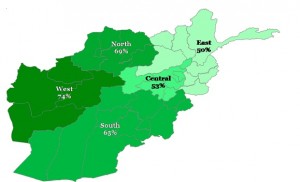Gallup’s poll on the wellbeing of Afghanistan — a country that has been on the receiving end of substantial investment in U.S. blood and treasure for well over a decade. The results are grim. (Darkest green areas on the map below are the most damaged).
Afghans’ ratings of their lives declined even further in 2014. More than six in 10 Afghans evaluate their lives poorly enough to be considered ‘suffering’ — the highest figure ever recorded for any country since Gallup started tracking life evaluations in 2005. As in 2013, no Afghans rate their lives highly enough to be considered ‘thriving.'”
The percentage of Afghans who described themselves as thriving was not always zero. In 2010, Gallup found the percentage up to 12 percent, having grown year-over-year since 2008. Not great, obviously, but at least moving in the right direction.
The South was a Taliban stronghold and reports indicate steady Taliban advances and bolder military assaults in the region, which likely contributes to the suffering rates (if not explains them outright). As for Western Afghanistan, it is, as Gallup notes, a bastion for opium addiction.
The NATO mission in Afghanistan ended this year. After 13 years, the costs and benefits of the U.S. nation-building committment there will certainly be debated for years, if not decades, to come. Most experts in the US State Department did not approve of continuing in the country when the Democrats, Obama and Secretary of State Clinton took over in 2008.

